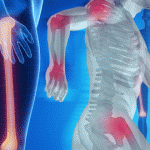Hip Pain Syndromes
To understand hip anatomy, look at the connections in the hip’s design, said Ingrid Möller, MD, PhD, assistant professor of anatomy and a rheumatologist at the University of Barcelona, Spain.
“The os coxae, or hip bone joints, are formed by the fusion of the ilium, ischium and pubis,” she said. “In this design, we want to confer elasticity to the pelvic ring and contribute to the transfer of weight from the spine to the lower limbs, as well as having a shock absorbing function that protects the spine. In that region, we have 27 muscles plus anatomical variations that cross the hip joint, acting as primary movers and dynamic stabilizers of the hip and the lower extremities.”
Hip anatomy adapted over time as the human gait evolved from quadrupedal to bipedal, said Dr. Möller. Our two-legged walk is facilitated by evolutionary adaptations of the lumbar spine, a shorter pelvis, double extension of the spine and hip, a longer femur, a larger ischium, and adaptations of muscle function in the hip region.15 These anatomical changes are relevant to understanding conditions like gluteal tendinopathy, the most prevalent tendinopathy in the lower extremities.16
Abductor and pelvic stabilizer muscles around the acetabulum “are really complex muscles, because the function changes from the anterior part of the joint to the medial and posterior aspects,” she said. They include the adductor muscles, lateral rotator muscles, and gluteal muscles, the gluteus minimus, medius and maximus.
“The gluteus minimus has in this lateral portion a function of flexion and medial rotation. But the gluteus medius makes more abduction. The gluteus maximus is doing extension and lateral rotation, plus abduction again,” Dr. Möller said. The goal of these multifunctional muscles is stabilization while we walk. “The position of the different muscles in relation to the acetabulum influences the action that they perform.”
Greater Trochanteric Pain Syndrome
Trochanteritis and bursitis of the hip are actually gluteal tendinopathy affecting the gluteus medius and minimus, and this is the primary pathology underlying greater trochanteric pain syndrome (GTPS), Dr. Möller said. Patients with GTPS present with “intermittent or chronic lateral hip pain with some radiation to the thigh or buttock area, and their pain is aggravated by some activities or lying on the affected side. But we lack validated or specific diagnostic criteria.”
GTPS has a multifactorial etiology that may involve biomechanics, abnormality of the lower limbs or abnormal force vectors across the hip joint, she said. It has a large prevalence, affects more females than males, and more often occurs after age 40.17 Dr. Möller shared a photo of her 60-year-old sister, a champion long-distance runner, to point out that GTPS prevalence is expected to rise as people live longer and more women engage in long-distance running.18
To examine patients with possible GTPS, try to reproduce the pain occurring with movement of the greater trochanter, said Dr. Möller. She suggested asking the patient to mimic the single leg stance of a flamingo. Differentiate GTPS from hip osteoarthritis by testing how well the patient can easily manipulate putting on shoes and socks, and with the flexion abduction external rotation (FABER) test to locate the source of the pain.19 Differentiate from low back pain by testing how well the patient rises from a seated position. If a patient has damage in the gluteus medius tendon, rising from a chair will be very difficult, she said.
“However, there is a weak association between physical examination and diagnosis, and if you trust in MRI [magnetic resonance imaging], a gold standard for many different conditions, there is no way to distinguish between asymptomatic and symptomatic patients,” Dr. Möller said.20 The hip and pelvic rotator mechanism involves synergy of two muscle groups: the trochanteric abductor muscles, including the gluteus minimus and medius, and the iliotibial tract tensor muscles, including the gluteus maximus, tensor fasciae latae and vastus lateralis, which may be clearly seen on an ultrasound scan.

